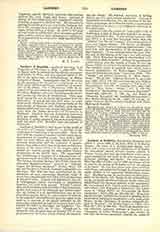

Lambert of Hersfeld , a medieval historian; b. in Franconia or Thuringia, c. 1024; d. after 1077. On March 15, 1058, he entered the Benedictine monastery of Hersfeld, in Hesse, and was ordained priest in the fall of the same year, at Aschaffenburg, by Bishop Liutpold of Mainz. Immediately after his elevation to the priesthood he started on a pilgrimage to the Holy Land without previously obtaining the permission of his abbot. On September 17, 1059, he returned to his monastery and asked and obtained from his abbot, Meginher, who was then lying on his deathbed, pardon for this act of disobedience. Only once more during the rest of his life did Lambert leave his monastery. It was in the year 1071 when, by order of his abbot, Rudhard, he spent fourteen weeks at the monasteries of Siegburg and Saalfeld, studying the reform which had been introduced into these monasteries from the Italian monastery of Fruttuaria in Piedmont. Lambert was not favorably impressed with the reform. In his opinion the old monastic discipline, if strictly observed, was more in accordance with the spirit of St. Benedict than the reform of Fruttuaria.
Lambert of Hersfeld is best known to the world as the author of “Annales Lamberti”, a chronicle of the world from its beginning to the year 1077. Up to the year 1040 the Annals of Lambert are little more than a reproduction of preceding annals; from 1040 to 1068 they are more diffuse, and to some extent based on personal observation and the authority of eyewitnesses; from 1068 to 1077 they widen into an elaborate history of the times written in the elegant style of Sallust and ranking among the most perfect literary productions of the Middle Ages. The impartiality and truthfulness of Lambert as a historian were unquestioned until the middle of the nineteenth century. The German historian Ranke [” Zur Kritik frankischdeutscher Reichsannalisten” printed in “Abhandlungen der Berliner Akademie” (Berlin, 1854), 436 sq.] was the first to discredit Lambert’s reliability as a historian. His view has been corroborated by the researches of most succeeding historians, some of whom have charged him even with willful falsifications of historical facts. Lefarth and Eigenbrodt (loc. cit. in bibliography below) attempted to rehabilitate Lambert, but with little success. Though Lambert may not have been a willful falsifier of historical facts, as has been asserted by Delbrack and Holder-Egger (loc. cit. below) it is an established fact that he was prejudiced against Henry IV, not so much on account of the emperor’s encroachments upon the rights of the pope as on account of the injury sustained by the monastery of Hersfeld through an imperial decree concerning the tithes in Thuringia (see Lambert’s “Annals”, ad annum 1073, pp. 141 sq.). Though not in sympathy with the great ideas of Gregory VII, he was prepossessed in his favor simply because the emperor was his enemy. His method, moreover, of writing history was to a great extent pragmatic. Instead of impartially investigating into the motives of his historical personages, he is often led by his prepossessions and prejudices to give a very subjective coloring to historical facts.
Lambert is also the author of “Vita Lulli” a life of Archbishop Lullus of Mainz who founded the monastery of Hersfeld in 768. It was written between 1063 and 1073, is of even less historical value than the “Annals”, but, like the “Annals”, it is a masterpiece of pure and elegant latinity. His history of Hersfeld, entitled “De Institution ecclesiae Hersveldensis”, has been lost, with the exception of the prologue and a few fragments. It was written before the year 1076. His epic on the history of his times has been entirely lost. Some historians thought it was identical with “Carmen de Bello Saxonico”, written by an unknown author shortly after the victory of Henry IV over the Saxons (1075), but of late this opinion has lost ground. The complete works of Lambert were edited, with a learned disquisition, by Holder-Egger “Lamperti monachi Hersfeldensis opera” (Hanover, 1894). The “Annals” are printed separately in “Mon. Germ.: Script.”, III, 22-263. They are also in P.L., up to the year 1040, CXLI, 450-582, and from the year 1040 to 1077, CXLVI, 1053-1248. Lambert’s “Vita Lulli” is also printed in Acta SS., October 16, VII, 1083-1091 and in “Mon. Germ.: Script.”, XV, I, 132-148. Gundlach in “Heldenlieder der deutschen Kaiserzeit” (Innsbruck, 1894-99), II, 191, sq., and Kurze in “Deutsche Zeitschrift fur Geschichtswissenschaft”, New Series (Freiburg im Br., 1898), II, 174 sq., attempt to prove that Lambert is identical with Abbot Hartwig of Hersfeld.
MICHAEL OTT

